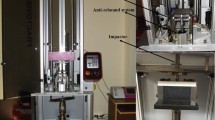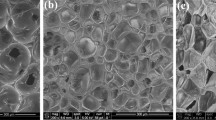Abstract
In this study, the effect of porosity on the dry sliding fiction of ethylene-vinyl acetate (EVA) foams was investigated under different normal load conditions. EVA foam blocks with varying porosities were slid against a smooth stainless steel plate under dry conditions. The friction coefficient increased with increasing porosity under all of the normal load conditions. In addition, the contact area was estimated using a contact model considering elastic buckling of the cell walls (elastic collapse). The elastic collapse area in the anterior portion of the EVA foam block increased with increasing normal load and porosity, which resulted in an increased contact area. Furthermore, the friction coefficient was positively correlated with the estimated contact area divided by the normal load, indicating that adhesion friction increases with increasing porosity of polymer foams. These results may contribute to the design of high-friction, lightweight shoe sole tread blocks prepared using polymer foam blocks.











Similar content being viewed by others
References
Su, B.-L., Sanchez, C., Yang, X.-Y.: Hierarchically Structured Porous Materials: From Nanoscience to Catalysis, Separation, Optics, Energy, and Life Science. Wiley, New York (2012)
Klempner, D., Frisch, K.C.: Handbook of Polymeric Foams and Foam Technology. Oxford University Press, Oxford (1991)
Gibson, L.J., Ashby, M.F.: Cellular Solids: Structure and Properties, 2nd edn. Cambridge University Press, Cambridge (1997)
Saha, M.C., Mahfuz, H., Jeelani, S.: Effect of density, microstructure, and strain rate on compression behavior of polymeric foams. Mater. Sci. Eng., A 406, 328–336 (2005)
Viot, P., Beani, F., Lataillade, J.L.: Polymeric foam behavior under dynamic compressive loading. J. Mater. Sci. 40, 5829–5837 (2005)
Oyachi, Y., Utsunomiya, H., Sakai, T., Yoshikawa, T., Tanaka, T.: Effects of porous surface layer on lubrication evaluated by ring compression friction test. ISIJ Int. 52, 858–862 (2012)
Cree, D., Pugh, M.: Dry wear and friction properties of an A356/SiC foam interpenetrating phase composite. Wear 272, 88–96 (2011)
Wang, J., Zhao, H., Huang, W., Wang, X.: Investigation of porous polyimide lubricant retainers to improve the performance of rolling bearings under conditions of starved lubrication. Wear 380–381, 52–58 (2017)
Hamid, A.A., Ghosh, P.K., Jain, S.C., Ray, S.: The influence of porosity and particles content on dry sliding wear of cast in situ Al(Ti)–Al2O3(TiO2) composite. Wear 265, 14–26 (2008)
Yamaguchi, T., Hokkirigawa, K.: Tribological properties and application of hard porous carbon materials “RB ceramics”. Jpn. Soc. Tribol. 52, 114–119 (2007). (in Japanese)
Dugarjav, T., Yamaguchi, T., Shibata, K., Hokkirigawa, K.: Friction and wear properties of rice husk under dry condition. J. Mech. Sci. Technol. 24, 85–88 (2010)
He, Y., et al.: Influence of porosity on friction and wear of tetragonal zirconia polycrystal. J. Am. Ceram. Soc. 80, 377–380 (1997)
Verdejo, R., Mills, N.: Performance of EVA foam in running shoes. In: Ujihashi, S., Haake, S.J. (eds.) The Engineering of Sport 4, pp. 580–587. Blackwell, Oxford (2002)
Verdejo, R., Mills, N.J.: Heel-shoe interactions and durability of EVA foam running-shoe midsoles. J. Biomech. 37, 1379–1386 (2004)
Moriyasu, K., Nishiwaki, T., Shibata, K., Yamaguchi, T., Hokkirigawa, K.: The effect of resin foam/rubber thickness ratio on frictional behavior of shoe sole material. In: Proceedings of 5th World Tribology Congress, pp. 290–293 (2013)
Yamaguchi, T., et al.: Dry sliding friction of ethylene vinyl acetate blocks: effect of porosity. Tribol. Int. 116, 264–271 (2017)
Bowen, F.P., Tabor, D.: The Friction and Lubrication of Solids. Clarendon Press, Oxford (1950)
Maegawa, S., Itoigawa, F., Nakamura, T.: A role of friction-induced torque in sliding friction of rubber materials. Tribol. Int. 93, 182–192 (2016)
Sheibert, J., Dysthe, D.K.: Role of friction-induced torque in stick-slip motion. Europhys. Lett. 92, 54001 (2010)
Author information
Authors and Affiliations
Corresponding author
Rights and permissions
About this article
Cite this article
Yamaguchi, T., Sugawara, T., Takahashi, M. et al. Effect of Porosity and Normal Load on Dry Sliding Friction of Polymer Foam Blocks. Tribol Lett 66, 34 (2018). https://doi.org/10.1007/s11249-018-0988-z
Received:
Accepted:
Published:
DOI: https://doi.org/10.1007/s11249-018-0988-z




